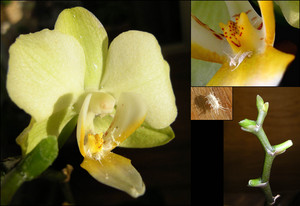Houseplants are not usually exposed to a lot of pests that generally bug your outdoor plants. Some common pests can at times get to them, though, which means you do need to pay attention to your houseplants and be aware of the signs of infestation. If you do see any of these four bugs that can commonly plague your plants, appropriate steps need to be taken to rid your houseplants of them before they can do a lot of harm or even kill the infected plant.
Mealybugs and Scales
Mealybugs are small and white with a cotton-like appearance. Scales are oval-shaped, tan, and have hard waxy shells. Both of these pests suck the sap from plants and exude a sticky substance called honeydew. This sap-sucking habit of mealybugs and scales will weaken the infected plant and eventually bring about its early demise if left untreated. Mealybugs will wrap themselves in a white cotton-y fluff, while scales will look like little raised bumps on your plants with the sticky honeydew being present.
To rid your houseplants of mealybugs and/or scales, simply dip a cotton ball in rubbing alcohol and clean the infected plant. (Avoid saturating the cotton ball, however, and using excess alcohol, which can damage your houseplants.) You can repeat this treatment as often as necessary.
Aphids and Spider Mites
Aphids are little oval-shaped pests that are usually green but can also be black, brown, gray, or light yellow. Spider mites are really tiny little red insects. Aphids feed on plant sap and can cause leaf malformation, as well as causing the leaves to turn yellow and die. Spider mites spin webs that can cover a plant and kill it if left untreated.
To rid your houseplants of aphids and spider mites, turn the infected plant upside-down and swish it around in a bucket of soapy water. After this treatment, spray off the soap residue with clear water. Repeat as often as necessary.
Susceptible Plants
While all plants are susceptible to attack by harmful insects, certain insects seem to have a preference for certain plants. For example, aphids like any plant that has soft stems and leaves, such as cyclamens and impatiens. Mealybugs like cacti and succulents. Scale insects will go after any member of the citrus family and ferns, especially bird’s nest ferns. Spider mites seem to prefer English ivy and spider plants. (I have noticed, however, that spider mites will sometimes appear on scheffleras. The alcohol treatment recommended for getting rid of mealybugs and scales works well to rid scheffleras of these little red microscopic pests.)
An Ounce of Prevention
Of course, the best thing you can do for houseplants is to keep the pests off them in the first place. Regular cleaning works wonders. Just wipe off your plants with a damp sponge or cloth. (Your plants will look better, too.) Giving your houseplants an occasional shower not only helps to raise the humidity [see my article Houseplants: Increasing the Humidity], it can also knock off many harmful insects before they take hold. If you move your houseplants outdoors in the spring and summer as I do, an occasional blast from the water hose can serve the same purpose. While mealybugs and scales tend to be impervious to water, you can knock most of them off with the hose before they really latch onto the plant. You can also whip up your own all-natural insecticide using herbs [see Making All-Natural Insect Repellents and Insecticides from Herbs], which will help to repel many harmful insects. Finally, always clean houseplants that have been outdoors well before bringing them back inside. You do not want to bring in pests that can spread to your other houseplants. Just remember that often merely taking proper care of your houseplants will normally keep pests away. [Be sure to read my article Houseplants: 5 Common Problems and Their Solutions.] Healthy plants are always more resistant to pests and diseases.
